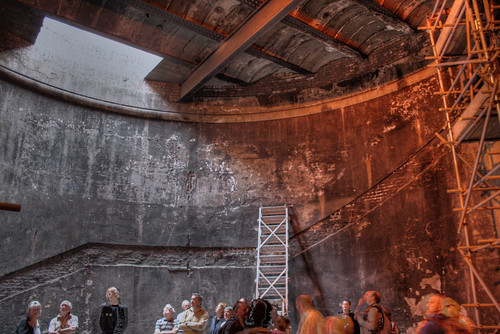Lurking not too far from where I live is a subterranean marvel that is considered to be one of the most important locations in engineering history. I am referring to the currently closed off East London Line railway – for the tunnel it runs through under the Thames is world’s first (successful) sub-aqueous tunnel.
Not too far from the Rotherhithe tunnel is the Brunel Museum situated within an old pumping station, but conveniently next to the original deep shaft that Marc Brunel (father of more famous Isambard Kingdom Brunel) sunk into the clay soil to get down to the depth where the tunnel would stretch out under the river.
I won’t relate the torturous history of the tunnel itself – as that is amply told elsewhere, for my visit to was not to the tunnel but to the remains of that original shaft.
I arrived at the museum just as a lot of people were filing out to go to the shaft, so I ahem, joined the crowd. I’ve been in the museum before as they used to run tours of the two key stations, Rotherhithe and Wapping, and take a slow train between them.
As part of the refurbishment of the tunnels for the overland railway, the shaft, which has always been empty from surface to deep underground has had a slab of concrete installed and the upper space will be handed over to the museum to clean up and turn into an extension. As the slab was finished off only a few weeks ago – the opportunity here was to see the interior of the shaft before it is cleaned up again.
Getting in for visitors will be down a replica of the original staircase that lined the tunnel when it was open to pedestrians – but our access was through a tiny door that you quite literally had to crawl through and then down some scaffolding to the floor, which is about 3 stories below its roofline (and about 2 stories below ground).
Here lots of photos were taken and a volunteer gave us a brief run through why the shaft is so important in engineering history and some details of its construction.
In essence, they had a huge metal ring, upon which they started building a high wall. As the wall got heavier, it started sinking into the soft soil – aided by workers inside digging out that soil. More bricks added, and the shaft continues to sink into the ground. At one point it got stuck and even adding 50,000 bricks to the top of the shaft wouldn’t unstick the gigantic pipe.
Here there seems to be two variants of the solution – in essence, water leaking into the shaft normally lubricated the sides and one weekend the whole thing dropped down several metres. Whether this was an accidental switching off of the water pumps over a weekend that had a fortuitous outcome, or a deliberate decision seems to vary depending on who is telling the tale.
The shaft finally at its required depth, the tunnel under the river could be cut out. A similar shaft on the north side was also built – although two more shaft, four times wider to allow horses down to the tunnel never got built as some idiot stuck a bridge at Tower Hill and ruined the finances of the tunnel.
Talk over and a climb back out through the tiny exit, and that was it. A short visit, but this subterranean geek was bouncing with delight to have been able to have a look around.
I took a quick look around the museum and picked up a guidebook that I would have brought last time I was there, only they couldn’t take cards and I was out of cash on the day. I also had a long chat with one of the staff about the pneumatic railway I am researching and he mentioned something about its precursor at Crystal Palace I wasn’t aware of. More research needed. Yay!
It was a shame we couldn’t go down to the original tunnels – but I have done a slow train tour through there before courtesy of the museum.
A slight rant – they let people into the shaft through a really tiny doorway – and yet other underground structures with significantly easier access points refuse to open up for the public visits due to “health & safety” concerns. That really annoys me as it quite evidently isn’t a problem.
As usual – more photos over at Flickr.









When you mention Crystal Palace, I wonder if you mean the strange water filled ring in the park.
Nick